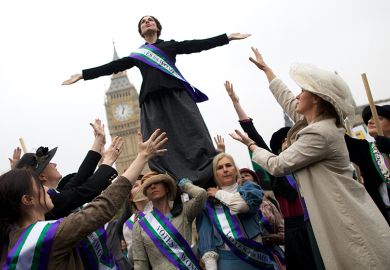Verily any people that has women as brave and noble as Iranian women will surely be victorious." Thus spoke Ayatollah Khomeini during the upheavals that led to the overthrow of the Shah in 1979. Later he acknowledged that women's support was the decisive factor in the success of his "Islamic" revolution.
In the West, we watched in astonishment news footage of demonstrations, with thousands of women in black chadar, shaking their fists and shouting "down with the Shah". The Shah, surveying the scene from his helicopter, is reported to have gasped: "Why the women?" It was a coup de grce: no ruler in the history of the country had done more to improve the status of women.
His father, Reza Shah, who had founded the Pahlavi dynasty in 1925, had abolished the veil in 1936 and started the process of women's emancipation. Within a generation Persian women had flourished in medicine, education and the civil service. Yet it was not until 1963 - under the late Shah - that they achieved the right to vote, enter the legal profession, the armed forces and the cabinet. The Shah's family protection law of 1966 gave them equality in marriage and divorce, the guardianship of their children, and pay equality. Iran became a model for other Middle Eastern countries in their "gender politics", as Ms Paidar puts it.
It was said that Persian women's donning of the chadar during the recent revolution was a "symbolic gesture . . . an assertion of their Islamic identity" against western imperialism and the Shah as its representative, while Khomeini promised them social justice and democracy. But (as Simone de Beauvoir has pointed out) all modern revolutionary movements use women first to gain power, promising them equality, then clamp down on them immediately afterwards.
Within a few weeks of coming to power, Khomeini declared that "women were naturally inferior", that "their presence in public places was seditious", and he made the "Islamic" hejab (head to foot covering) compulsory: "women were barred from becoming judges . . . He decreed that beaches would be segregated . . . the segregation of sport . . . abolition of co-educational schools . . . [a few days later] came the first news of flogging of a man and a woman for adultery . . . followed a couple of months later by the first stoning of a woman for adultery in Behshahr." Women were "encouraged" to stay at home instead of seeking employment. They poured into the streets, protesting against the new measures, but were brutally suppressed.
Later factional power struggles in the government and the 1981-88 Iran-Iraq war diverted their struggle to survival. Soon it became clear that the country could not afford to lose half its work force. With the agility of an acrobat twisting in mid air, the government changed its "discourse", and women were encouraged to participate in national life not only as wives and mothers, but as workers.
Histories of modern Iran and of the 1979 revolution in particular have dealt with gender marginally. Parvin Paidar's lucid study successfully demonstrates the centrality of women in the political process.
Paidar goes back to the 19th century when Persia became the highest stake in the Great Game - the rivalry between Britain and Russia for the control of the Middle East. The absolutist monarchy of the Qajar Shahs initiated the overture to the West. Women, though veiled and secluded, participated fully in politics through behind-the-scenes activity and influence. Paidar cites Mahde-Olya, Nasseroddin Shah's mother, "a shrewd politician and strong-willed woman who practically ran the country . . . and used her influence to remove and murder Amir Kabir - her son's enlightened Grand Vizir who started Persia's modernisation - in 1848". To this day, Iranians believe that had Amir Kabir remained in power, Persia's history would have taken a different, more progressive course.
Women's direct participation in the political process started with the constitutional revolution of 1906-11, resulting in the abolition of absolutism, the introduction of constitutional monarchy and parliamentary democracy. Women joined the constitutionalist movement through riots, female gatherings and dissemination of information. Even the Shah's wives disobeyed him. Later, when the new parliament failed them, they proposed to run the country, promising to do a better job of it than men.
The seed of a feminist movement was sown, which would grow and bear fruit in the course of the following decades. When Reza Shah came to power in 1925, he established a strong central government and started a programme of rapid modernisation, in which women's emancipation was an essential part. He subdued the reactionary clerics, silenced the opposition, and set the scene for the "lifting of the veil" in 1936. The first women's centre was established under the chairmanship of his eldest daughter, and soon Iran became the leader of the modernisation movement in the Middle East.
Yet, as Paidar points out, modernisation did not "foresee the rise of Islamic populism". As a result after the war, when the late Shah came to power, new "discourses" entered the political arena: the neo-Marxist theories of development, which opposed "capitalist modernisation", and maintained that women were victims of "imperialism, that their chains would drop when the masses were liberated".
More potent and appealing than Marxism was "political Islam", which came to the fore in the 1970s. Its chief theoretician was western-educated economist Ali Shariati, who did not advocate "a return to the tradition", but laid claim to modernity, with "Islam as an instrument of progress". He located the oppression of women in "cultural imperialism", "the greatest conspiracy against humanity", and maintained that the "discourse of gender equality was a western product", that instead of being passive consumers and sexual objects, women should wear the hejab and participate as sovereign agents in social transformation.
Shariati's influence diminished after his death, shortly before the 1979 revolution. With the subsequent clamp-down on women, and the rise of fundamentalism elsewhere in the Middle East, the old theory of Islam as the cause of women's oppression has returned, particularly in the West. Yet there has never been such an abundance of Islamic feminist literature putting the case in favour of Islam as a doctrine of gender equality and an instrument of social progress. Paidar's ample bibliography cites many publications on the subject, including the seminal works of Moroccan sociologist and historian Fatimah Mernissi.
Whatever one's political views and criticisms of the Shah's regime, after reading Parvin Paidar's admirable book one cannot help feeling that, for women at least, the Pahlavi period was a lucky parenthesis in the history of Persia. "Before" was veiling and seclusion, "after" is a new form of veiling and lack of sovereignty. But that 50-year fluke parenthesis has enabled one Persian woman to write the history of Persian women in this turbulent century, and another to review it.
Shusha Guppy is a freelance writer on Middle East issues.
Women and the Political Process in 20th-Century Iran
Author - Parvin Paidar
ISBN - 0521 473 403
Publisher - Cambridge University Press
Price - £35.00
Pages - 417
Register to continue
Why register?
- Registration is free and only takes a moment
- Once registered, you can read 3 articles a month
- Sign up for our newsletter
Subscribe
Or subscribe for unlimited access to:
- Unlimited access to news, views, insights & reviews
- Digital editions
- Digital access to THE’s university and college rankings analysis
Already registered or a current subscriber?



